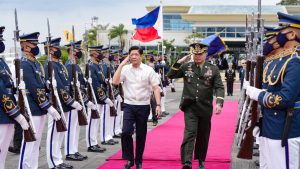Philippine President Ferdinand Marcos Jr. yesterday embarked on a four-day working visit to Japan that is aimed at reinforcing the “strong and vibrant relations” between the two countries.
The working visit, which will run from February 8 until February 12, will include a meeting with Japanese Prime Minister Kishida Fumio and an audience with Emperor Naruhito. In a statement delivered prior to his departure from Manila, Marcos described the trip as “essential” and said that it would focus on reinforcing the two nations’ ever-closer defense and investment ties.
The trip “is part of a larger foreign policy agenda to forge closer political ties, stronger defense, and security cooperation, as well as lasting economic partnerships with major countries in the region amid a challenging global environment,” Marcos said.
While in Japan, he said his team will work on further strengthening “the bonds of friendship with a close neighbor, like-minded and future-oriented like us in many ways, and a most reliable partner in times of both crises and prosperity.”
In a statement, the Philippine Department of Foreign Affairs said that Marcos will witness the signing of at least seven key agreements focusing on infrastructure development, defense, agriculture, and information and communications technology. It also said that he was expected to finalize $2.7 billion in investment deals that could create 8,000 jobs in the Philippines.
Marcos’ visit to Japan – his ninth overseas trip since taking office in July of last year – comes on the heels of a major upgrade in the Philippines’ relationship with the United States, in which Marcos’ administration agreed to give U.S. forces access to four additional military bases, including on the northern island of Luzon. The access has been granted under the 2014 Enhanced Defense Cooperation Agreement (EDCA), which fell into abeyance under the administration of President Rodrigo Duterte, who spurned the country’s U.S. alliance and pivoted the country toward closer relations with China.
Good relations with Japan, meanwhile, have been one of the constants of Philippine foreign relations dating right back to 1977, when former Japanese Prime Minister Fukuda Takeo delivered his famous “Fukuda Doctrine” speech in Manila. The speech directly addressed imperial Japan’s brutal occupation of large parts of Southeast Asia during World War II and helped end a dark chapter of Tokyo’s relations with the region. Indeed, in more recent times, Japan is one of the few nations that managed to maintain good relations with the Philippines through the lurching transition from the pro-American administration of Benigno Aquino III (2010-2016) to the tumultuous Duterte era, and now to the Marcos administration.
In particular, Manila and Tokyo have in recent years augmented their long-standing economic ties – Japan was the first nation to sign a free trade agreement with the Philippines, in 2008 – with closer defense cooperation.
The two nations signed a strategic partnership in 2011 and five years later, brokered a new defense agreement allowing the transfer of defense equipment and technology from Japan to the Philippines. Since then, Japan has helped modernize the Philippine Coast Guard, and sent observers to last year’s Kamandag 6 war games between the U.S. and Philippine militaries, while boosting its own bilateral military exercises with the Philippine military.
This convergence reflects their shared sense of threat from China, with which they both have unresolved maritime and territorial disputes, in the South China and East China seas, respectively. Both nations would also likely experience the backwash from any conflict over Taiwan, which lies between the two nations. As long as the regional tensions between China and the U.S. and its partners continue, we can expect further convergences between Tokyo and Manila.

































